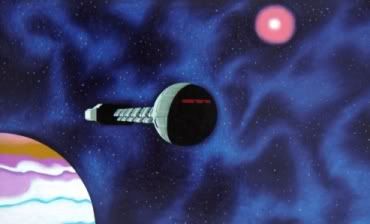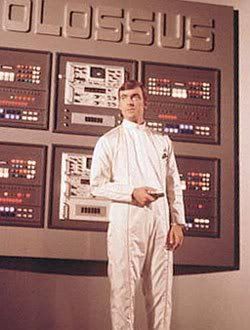CIS Destroyer Starship, Top 10 Movies, Samson vs. The Vampire Women, and Our 2nd SF Quiz
Privyet Kosmonati,
At the risk of being labeled a “beanie-wearing fan with a SF hardware fetish” as some wags have recently described lovers of classic science fiction, the next segment of my Kosmosflot universe is about a starship, the Provorny (Agile) class destroyer that will be spotlighted in my first collection of stories. Secure your helmet, activate your oxygen generator, and here we go:
Kosmosflot Universe: Starship Destroyer
 The Commonwealth of Independent Stars, the CIS, maintains a huge starship navy. It’s based on an extension of army-air force traditions, unlike the too-many-to-count wet navy versions so popular today. I don’t know about you, but I’ve grown weary of so many modern space operas reading like Horatio Hornblower or Mutiny on the Bounty. I, too, enjoy a good sea-faring yarn, but not all over the entire universe, please.
The Commonwealth of Independent Stars, the CIS, maintains a huge starship navy. It’s based on an extension of army-air force traditions, unlike the too-many-to-count wet navy versions so popular today. I don’t know about you, but I’ve grown weary of so many modern space operas reading like Horatio Hornblower or Mutiny on the Bounty. I, too, enjoy a good sea-faring yarn, but not all over the entire universe, please.One conflict that I hope to explore in Kosmosflot is between the advocates for the big battlewagons versus the more economically-minded proponents of smaller, faster starships. And note that I said smaller starships, not fighters. I’m not going to revisit Top Gun or the carriers versus capital ship arguments per se. I’ve made the definite decision that small fighters aren’t going to be survivable in deep-space combat, for lack of power and weapons capability. Small starships like gunboats, frigates, and destroyers will be viable. Yes, fighters will have a place for in-system defense, but even so, they’re going to be considered suicidal at best.
As for the Povorny-class destroyer, automation greatly reduces the crew requirements to about 30-to-35 able-bodied spacemen and spacewomen. And, following the Russian military model that is prevalent in Kosmosflot, the crew is officer-heavy, including many warrant officers, the “Praporshchiki.” Technical and engineering tasks are done by officers, not enlisted men like in the US armed forces.
Here are some of the specifications for CIS DD-6941, code name Meineke Draken, “Little Dragon”:
Construction: Dustri Starship Production Complex
Age of Vessel: 75 years
Originally designated RD-6941, Recon-Destroyer, redesignated DD after refit
Tonnage: 5,000 tons
Crew: 33
Primary Powerplants: 2 5000 megawatt Cold Fusion Reactors
Secondary Powerplants: 2 1000 megawatt Cold Fusion Reactors
FTL Drive: Astronian Class-50 Quantum Vacuum Cylinder
Range: 50 light years per transition
Thurster Drive: Two Kuznetsov 6G Standard Engines
Anti-Grav Capability: Three Active/Passive Generators
Endurance: 120 days normal, 180 days restricted
Armaments: 4 35-centimeter 5000 megawatt Luztron laser
Dual missile bays
Defense Systems: N-2 Class Force Field keyed on FTL Drive; Advanced Armor Hull; Advanced Stealth EM Complex
This Little Dragon has a sphere-shaped main hull, with a short-and-straight boom connecting it to a boxy secondary hull. Tin cans like this are cheap to produce (compared to big battlewagons), and are fast and small enough to be stealthy when they employ countermeasures (or hide behind the nearest asteroid!). Destroyers have enough endurance and punch to undertake solitary missions, and are always on-call as escorts for fleet and convoy duty. DD-6941 is an old ship and saw action in the Muj War (2480-2490), and later did deep-space exploration in the Genex Zone. It went into the Inactive Reserve Fleet in 2496, and was refitted, updated, and rechristened when more bad things started happening in “our” part of the galaxy. In the next blog I’ll review the Astronian alien-technology FTL drive and its tie-in to the communictions and force field systems that are widely used in the CIS Space Army.
Captain Kosmos’ Top Ten Favorites List of SF and Horror Films
Last time I listed my Top Ten Guilty Pleasures in SF & Horror Films. Let’s go to the other end of the scale: Captain Kosmos’ Top Ten Favorites List of SF and Horror Films, the best of the best:
1. Island of Lost Souls (1937)
2. The Day The Earth Stood Still (1951)
3. The War of the Worlds (1953)
4. 20,000 Leagues Under the Sea (1954)
5. Forbidden Planet (1956)
6. Robinson Crusoe on Mars (1963)
7. 2001: A Space Odyssey (1968)
8. Soylent Green (1973)
9. Blade Runner (1983)
10. Solaris (2003)
Your comments and your own Top Ten choices are welcome in the comments section.
A Guility Pleasure Favorite: Santo!
Nightmare Theater was central Indiana’s favorite horror and SF movie show in the 60s and early 70s, hosted by the beloved vampire Sammy Terry. Every week, kids all over the Hoosier state would check the Sunday edition of the Indianapolis Star TV guide to see what film Sammy would be featuring on his next program, usually broadcast Saturday evenings at 10 p.m. During the late 60s, about two dozen Mexican horror films made their way into Sammy’s dungeon. They were imported and dubbed by producer K. Gordon Murray, better known for his imported kiddie matinee films. I remember watching Brainiac, The Robot vs. The Aztec Mummy, and the Vampire Nostradamus. But the best of these south-of-the-border monster movies was the Samson series.
 Known as “El Santo” in Mexico, this silver-masked superhero was also a championship wrestler, drove a hot little sports car, and was always battling supernatural fiends. And like so many dubbed films, they were often unintentionally hilarious. My favorite, Samson vs. The Vampire Women, is a perfect example.
Known as “El Santo” in Mexico, this silver-masked superhero was also a championship wrestler, drove a hot little sports car, and was always battling supernatural fiends. And like so many dubbed films, they were often unintentionally hilarious. My favorite, Samson vs. The Vampire Women, is a perfect example.The greatest scene in the movie would make Hulk Hogan (or Indiana’s famous Dick the Bruiser) rightly proud. In the middle of the film, Samson takes time off from his investigation of seductive, blood-sucking vampire women to wrestle “The Black Mask.” He doesn’t know that the real Black Mask has been cold-cocked by one of the vampire women’s ghouls, and that he’ll actually be facing a super-strength killer in the ring. When the match starts, the imposter Black Mask attacks Samson in a berserker frenzy, pommeling him with non-stop blows and karate chops. It looks bad for Samson, but he survives the first round, and is able to regain his strength during the break.
The second and final round is the film’s greatest, most memorable scene. The bogus Black Mask puts Samson into a back-breaker hold, and attempts to remove his silver mask. The Mexican crowd chants (in Spanish) SANTO! SANTO! SANTO! And in a quick reversal, Samson is able to regain control of his crazed opponent. He rips off the Black Mask’s headgear to reveal he has been fighting a WEREWOLF! And, man, is this werewolf one pissed-off lycanthrope! Samson staggers back in shock, and the hairy-faced monster snarls and roars at the panicking audience. The wrestling fans quickly decide that a foaming-at-the-mouth, mad-as-hell werewolf was not what they paid to see, and a mad stampede to the arena exits ensues.
Next, the crazed werewolf bashes the poor referee unconscious, then other wrestlers start jumping into the ring to help Samson subdue the monster. The hairy brute makes short work of them, too, and soon the ring is piled up with bodies! It’s reminiscent of the Three Stooges film where Curly becomes homicidal when he hears Pop Goes The Weasel. Then the arena’s security policemen join in, but this werewolf won’t quit! It attempts to bash and lash the oncoming squad of Mexico City’s finest. Only a volley of pistol fire finally compels the werewolf to transform into a bat (I guess he was a Mexican werewolf/vampire hybrid), and it flaps its way to escape.
Whenever Samson vs. The Vampire Women was shown on Nightmare Theater, my school buddies and I would get together, open a big can of Charle’s Potato Chips, and have a great time cheering Samson on to victory. We had never seen anything as bizarre as this superhero/wrestler/monster-fighter character. And despite the hokum, the cheap effects and over-the-top makeup, every now and then the mood and atmosphere in those south-of-the-border horror shows got it right and were, indeed, some very scary entertainment. Especially for a pack of young monster-movie fans on a Saturday night. You can read more about Samson and the other cult film legends from Mexico at the excellent web site:
THE WONDERFUL WORLD OF K. GORDON MURRAY.
CAPTAIN KOSMOS’ QUIZ
 In the 1970 film COLOSSUS, THE FORBIN PROJECT, and in the original novel by D.F. Jones, the United States builds a supercomputer to control all its nuclear missiles. All the Western world’s strategic weapons are turned over to this system, called Colossus. Its first message after coming online is, “Warning: There is another system.” It’s soon confirmed that the Soviet Union is about to boot up its own super-cyber defense computer named Guardian. The story develops as Colossus and Guardian link up in their own ad hoc point-to-point network, and begin sharing data and computing capacity. America’s chief computer designer, Charles Forbin, soon regrets that he built Colossus without an off switch.
In the 1970 film COLOSSUS, THE FORBIN PROJECT, and in the original novel by D.F. Jones, the United States builds a supercomputer to control all its nuclear missiles. All the Western world’s strategic weapons are turned over to this system, called Colossus. Its first message after coming online is, “Warning: There is another system.” It’s soon confirmed that the Soviet Union is about to boot up its own super-cyber defense computer named Guardian. The story develops as Colossus and Guardian link up in their own ad hoc point-to-point network, and begin sharing data and computing capacity. America’s chief computer designer, Charles Forbin, soon regrets that he built Colossus without an off switch.Colossus’s central-processing units were located deep in the Rocky Mountains, surrounded by an inpenetrable moat-barrier of lethal radioactive waste. The quiz question is: Where was Guardian’s computer core located in the USSR? Hint: there are two possible answers, both correct.
 The first reader to correctly answer this blog’s quiz will win a copy of THE INVADERS by Keith Laumer, the paperback novel based on the 1967 TV series, one of the Captain’s favorite SF television programs. Please post your answers in the comment section.
The first reader to correctly answer this blog’s quiz will win a copy of THE INVADERS by Keith Laumer, the paperback novel based on the 1967 TV series, one of the Captain’s favorite SF television programs. Please post your answers in the comment section.Until next time, D’os Vadanya
CAPTAIN KOSMOS
Technorati tags: science fiction, sci-fi, sf, films, movies, writing





0 Comments:
Post a Comment
<< Home